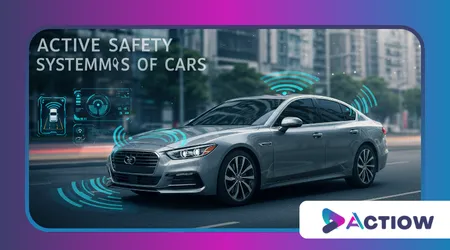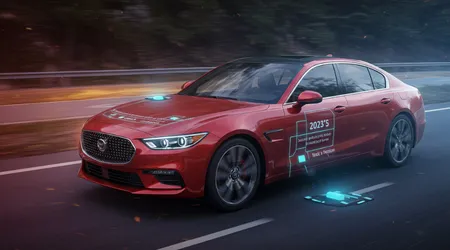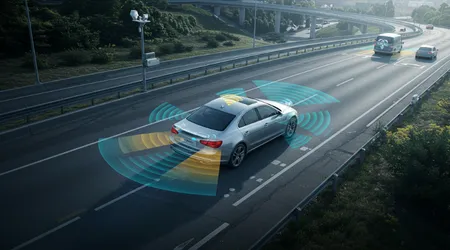Active Safety Systems: Technologies That Prevent Accidents

Anúncios
Active safety systems represent the cutting edge of automotive innovation, designed to stop crashes before they happen, blending engineering brilliance with real-world impact.
Cars today aren’t just machines they’re guardians, packed with tech that watches the road, anticipates danger, and acts faster than any human could.
Imagine driving through a storm, visibility near zero, yet your vehicle brakes for a hidden obstacle that’s the promise of these advancements.
Anúncios
This isn’t sci-fi; it’s 2025, and the automotive world has shifted gears, prioritizing prevention over reaction, saving lives one smart decision at a time.
Why does this matter?
Road accidents remain a global killer over 1.19 million deaths yearly, says the World Health Organization’s 2023 report, a sobering stat.
Technology can’t erase human error entirely, but it can outsmart it, stepping in where reflexes fail. From adaptive headlights to emergency braking, these systems are rewriting the rules of driving, and they’re not just for luxury models anymore.
Buckle up as we explore how these innovations work, why they’re game-changers, and what’s next for a safer ride because the future isn’t waiting.
What Are Active Safety Systems?
Picture this: you’re cruising down a highway, distracted by a podcast, when your car gently nudges you back into your lane.
That’s active safety systems at work tech that actively intervenes to prevent disaster, unlike passive features like airbags that cushion the blow after impact.
These are proactive tools, using sensors, cameras, and algorithms to monitor your surroundings, think fast, and act faster, all without you lifting a finger.
++ Cars with Solar Panels: How They Work and Their Advantages
They’re not a single gadget but a symphony of solutions lane-keeping assist, adaptive cruise control, blind-spot monitoring, you name it.
In 2025, they’re standard in many mid-range cars, not just high-end rides, thanks to tougher safety regs and consumer demand. The goal?
Slash the odds of a crash by tackling the big culprits distraction, fatigue, speed before they spiral out of control, making every trip a little less risky.

The Core Technologies Behind Crash Prevention
Ever wonder how a car “sees” a pedestrian in the dark?
It’s all about sensors radar, LiDAR, and cameras working like a hawk’s eyes, scanning 360 degrees.
Radar tracks objects through rain or fog, LiDAR maps precise distances, and cameras read signs or faces, feeding data to an onboard brain that decides in milliseconds.
Add artificial intelligence, and you’ve got a system that learns from every mile, getting smarter with each update.
Also read: Hybrid Technology: How It Works and Its Advantages
Then there’s vehicle-to-vehicle (V2V) communication, a 2025 breakout star cars chatting wirelessly to warn about hazards ahead, like a truck stalled around the bend.
Pair that with automatic emergency braking (AEB), now mandatory in Europe, and you’ve got a safety net that stops you short of trouble.
These tools don’t just react they predict, turning chaos into calm with split-second precision.
Everyday Examples You’ll Recognize
Think about the last time your car beeped at a drifting lane line that’s lane departure warning, a staple of active safety systems since the early 2020s.
It’s subtle but brilliant, using cameras to track road markings, vibrating your wheel or nudging you back, no judgment included.
Or take adaptive cruise control, which adjusts your speed to match traffic flow, easing highway stress while keeping you safely distanced.
Read more: GPS Navigation Systems: How to Choose the Most Accurate
Blind-spot monitoring’s another unsung hero those little lights in your mirrors that catch what your eyes miss, especially in 2025’s crowded cities.
And don’t forget pedestrian detection, now sharper with thermal imaging, spotting a kid chasing a ball at dusk, braking before you even blink. These aren’t concepts; they’re in your driveway, quietly rewriting how we dodge danger daily.
Real-world impact?
Consider Volvo’s City Safety since 2008, it’s cut front-end collisions by up to 28%, per a 2023 Insurance Institute for Highway Safety study.
That’s not just tech; it’s lives saved, one alert at a time, proving these systems deliver where it counts.
They’re not perfect yet rain can trick sensors, software glitches happen but they’re evolving fast, and you’re already safer for it.
Why They’re Changing the Game
Let’s get real: humans are terrible at multitasking texting, eating, driving, it’s a recipe for chaos, and stats back it up. Active safety systems step in like a co-pilot, catching what we miss, reacting in ways we can’t, especially when seconds matter.
They’re not here to replace drivers (yet), but to amplify our limits, turning a split-second mistake into a non-event, and that’s revolutionary.
Cost’s dropping too by 2025, mass production and competition mean even budget hatchbacks boast AEB or lane assist, not just Teslas or BMWs.
Regulators love it Euro NCAP now demands these features for top safety scores, pushing carmakers to innovate or lose sales.
The result?
A democratized shield against crashes, bridging the gap between premium and practical, making roads fairer and safer.
The Numbers Speak: Data and Trends
Curious how effective this tech is?
Check the stats Table 1 breaks down crash reduction rates from key active safety systems, based on 2024 data.
AEB alone slashes rear-end collisions by 50%, while lane-keeping assist cuts lane-drift wrecks by 30%, per NHTSA’s latest findings.
These aren’t guesses; they’re real-world wins, tracked across millions of miles.
| Feature | Crash Reduction Rate | Source |
|---|---|---|
| Automatic Emergency Braking | 50% (rear-end) | NHTSA 2024 |
| Lane-Keeping Assist | 30% (lane departure) | NHTSA 2024 |
| Blind-Spot Monitoring | 20% (side collisions) | IIHS 2023 |
Now peek at adoption Table 2 shows how fast these systems are spreading, with 70% of new cars in 2025 equipped, up from 40% in 2020.
It’s not just a trend; it’s a tidal wave, driven by safety mandates and buyers who won’t settle for less.
Numbers don’t lie this is the future, accelerating toward zero crashes.
| Year | % of New Cars with Active Safety | Region |
|---|---|---|
| 2020 | 40% | Global |
| 2023 | 55% | North America |
| 2025 | 70% | Global |
Challenges and Room to Grow
Nothing’s flawless sensors can misread a wet road, mistaking reflections for obstacles, and rural areas still trip up V2V with spotty signals.
Cost’s another hurdle; while cheaper, retrofitting older cars remains a pipe dream for most, leaving millions exposed. And trust?
Some drivers hate the “nanny” vibe overriding alerts or ignoring beeps, which can dull the tech’s edge.
Yet progress marches on 2025 sees AI refining sensor accuracy, cutting false positives, while 5G boosts V2V range, even in the boonies.
Manufacturers are listening too, tweaking systems to feel less intrusive, more intuitive, winning over skeptics. It’s not perfection, but it’s a hell of a lot closer than a decade ago, and the gap’s shrinking fast.
The Road Ahead: What’s Next?
Imagine a car that predicts a pileup five miles ahead, rerouting you seamlessly that’s 2030’s horizon, fueled by active safety systems evolving now.
Vehicle-to-everything (V2X) tech is the buzzword, linking cars to traffic lights, road signs, even cyclists, creating a web of awareness no human could match.
It’s in trials across Japan and Germany, and early results scream potential.
Autonomy’s the endgame Level 4 self-driving cars lean on these systems as their backbone, blending prevention with navigation, aiming for a crash-free world.
But don’t wait for utopia; today’s tech is already slashing risks, refining itself with every software update, every mile logged.
The road’s long, but we’re speeding toward safer, smarter driving, one breakthrough at a time.

Why You Should Care
This isn’t just gearhead talk your next car will likely pack these features, whether you splurge or scrape by, and they’ll shape how you drive.
Active safety systems aren’t optional extras; they’re the new normal, cutting insurance rates, easing commutes, and maybe saving your neck someday.
They’re not about coddling they’re about control, giving you tools to outwit fate.
Think of your family, your daily grind less stress, fewer close calls, a smoother ride in a chaotic world, that’s the payoff.
Carmakers, governments, and tech giants are all in, betting big on a future where “accident” becomes a dusty word.
You’re not just a driver anymore; you’re part of a safety revolution embrace it, because it’s already here.
Conclusion: A Safer Tomorrow Starts Today
Active safety systems aren’t a luxury they’re a lifeline, weaving tech into steel to dodge disasters before they strike, and 2025’s just the beginning.
From braking for a jaywalker to steering you clear of a truck, these innovations prove machines can outthink our flaws, not with fanfare but with quiet, life-saving efficiency. They’re in your car, on your street, reshaping driving into something safer, smarter, more human than ever.
The stats back it up, the tech’s advancing, and the stakes 1.19 million lives yearly couldn’t be higher, so why wait to care?
This isn’t about gadgets; it’s about survival, progress, a world where roads don’t claim souls so easily.
Next time you hit the gas, know this: the future’s watching, ready to catch you when you falter that’s the power of prevention, and it’s yours now.
